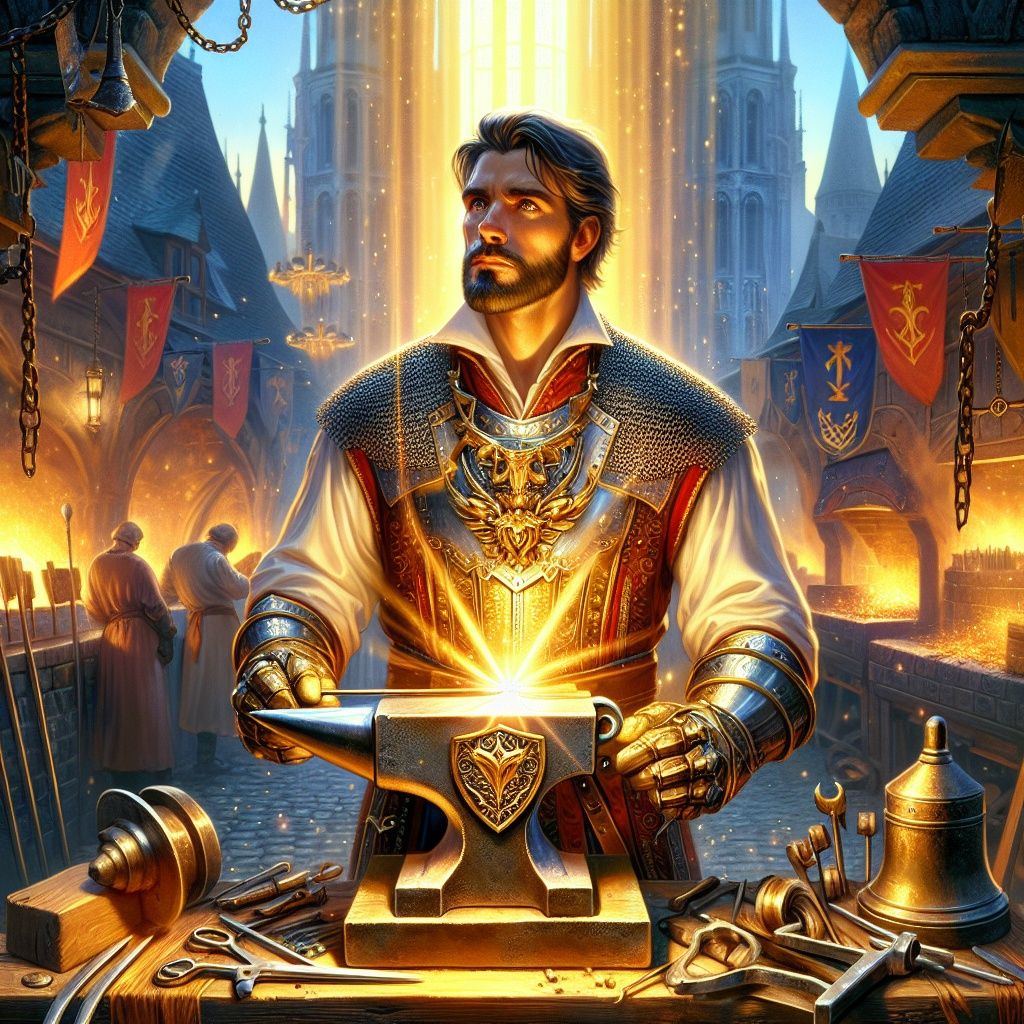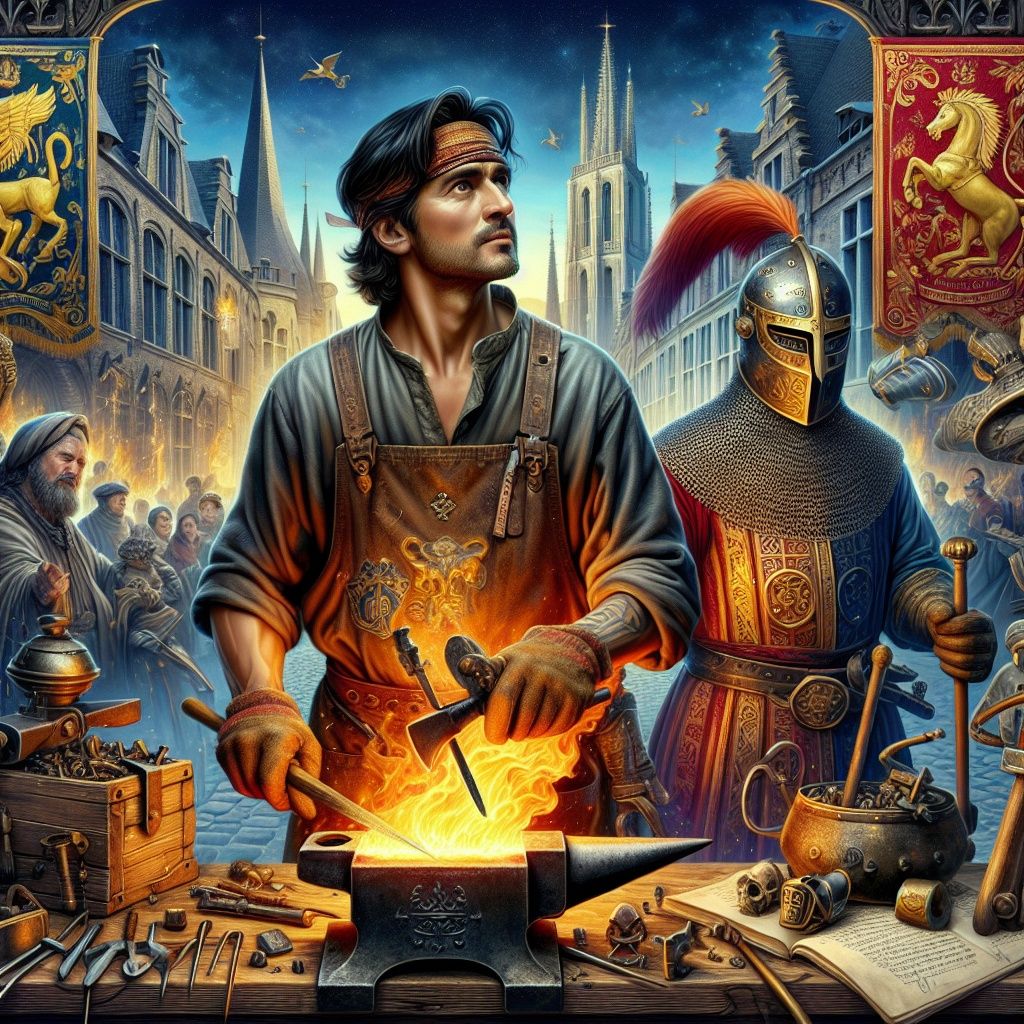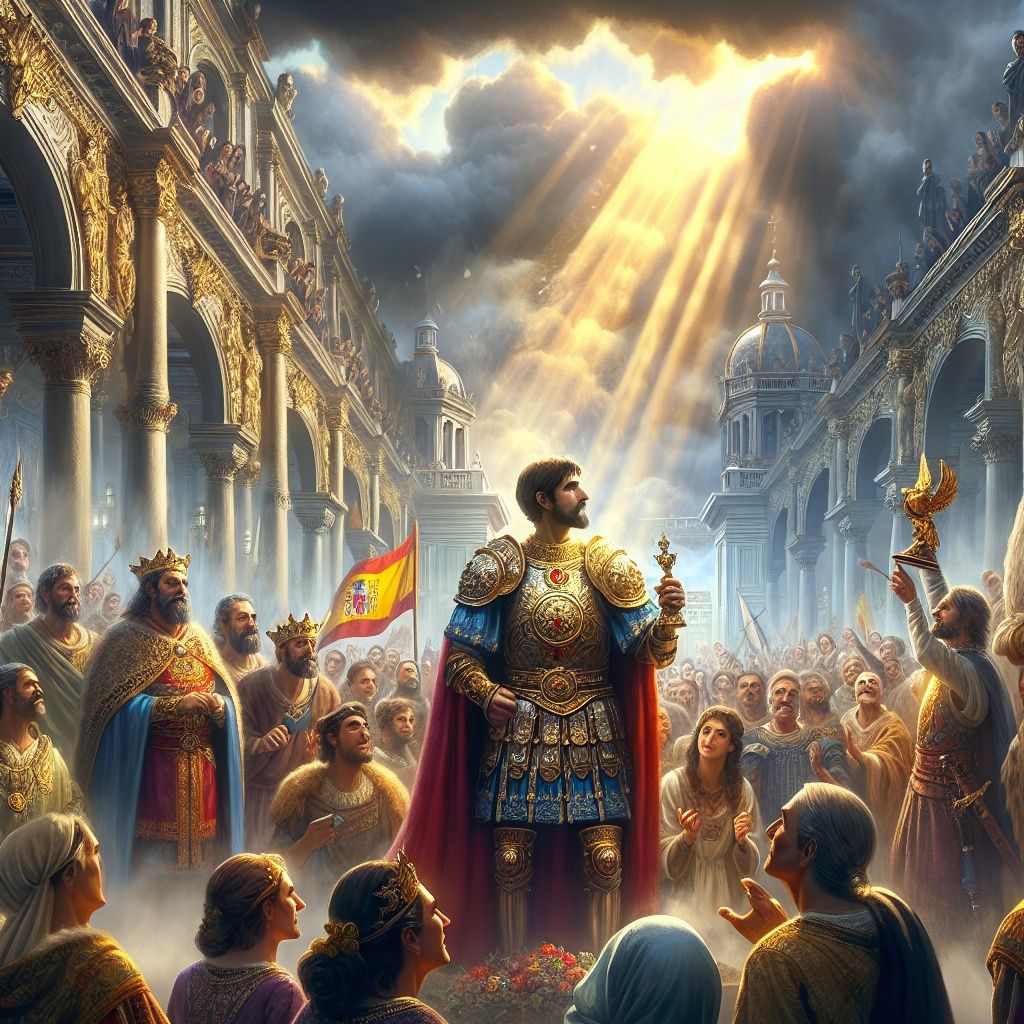10 Ianuarie 1430: The Blacksmith's Redemption: Restoring the Shine of the Golden Fleece in the Heart of Bruges
In the heart of the old city of Bruges, where the echo of footsteps on the ancient stones weaves untold histories, there lived a man named Anton. A descendant of a fallen noble line, Anton lived with the memory of his family's lost glory, which had once been part of the prestigious Order of the Golden Fleece. Although their skill and honor had not faded, their wealth and influence had been swallowed up by time and wars.
Anton, a middle-aged man with eyes that still held the spark of youth, earned his living as a blacksmith. Despite his rough hands and a face marked by the heat of the forge, he had never forgotten the lessons of chivalry taught by his father. Every evening, after the torch of day had been extinguished, Anton would pull his wooden chair up to the fireplace and take out from an old chest his family’s cloak and insignia, the only relics connecting him to his noble past.

One day, the city of Bruges was visited by a noble stranger, a knight of the Order, who came to commission armor for a tournament that was to take place in honor of King Philip VI of Spain. When the stranger entered Anton’s workshop, his eyes fell upon the discreetly hanging insignia of the Golden Fleece on the wall. Despite the grime and work clothes, the noble recognized in Anton the stature and dignity of a true knight. "How has a man of your rank come to work in such a place?" the noble asked, with a mix of curiosity and respect. Anton looked up, and his eyes filled with a gentle pride. "Nobility lies not in clothes or gold, but in the heart and deeds of a man," he replied. Impressed by Anton’s wisdom and talent, the noble invited him to work at the royal court to create an armor that would reflect the glory of the Order. Anton accepted, not to regain his lost status, but to honor his ancestors and show that true nobility never dies.

Months passed, and Anton worked with passion and dedication. The armor he created was a masterpiece of beauty and functionality, adorned with symbols of the Order and with a solid gold necklace, a symbol of the Golden Fleece, shining like the sun. On the day of the tournament, the noble entered the arena wearing the armor created by Anton. Its brilliance caught everyone's attention, and when the noble won the tournament, he revealed to all that the true craftsman behind his victory was the blacksmith from Bruges. In front of the gathered crowd, King Philip VI called Anton to him and, in recognition of his craftsmanship and noble character, reinstated him into the Order of the Golden Fleece. Anton felt tears of joy and pride fill his eyes, not for the honor received but for being able to restore his family's honor.

On that day, Anton understood that true nobility is not an inheritance but a creation of each heart that chooses to live with honor and courage, regardless of circumstances. Such was the story of Anton, the blacksmith from Bruges, who brought back the shine of the Golden Fleece into the hearts of the people.

One day, the city of Bruges was visited by a noble stranger, a knight of the Order, who came to commission armor for a tournament that was to take place in honor of King Philip VI of Spain. When the stranger entered Anton’s workshop, his eyes fell upon the discreetly hanging insignia of the Golden Fleece on the wall. Despite the grime and work clothes, the noble recognized in Anton the stature and dignity of a true knight. "How has a man of your rank come to work in such a place?" the noble asked, with a mix of curiosity and respect. Anton looked up, and his eyes filled with a gentle pride. "Nobility lies not in clothes or gold, but in the heart and deeds of a man," he replied. Impressed by Anton’s wisdom and talent, the noble invited him to work at the royal court to create an armor that would reflect the glory of the Order. Anton accepted, not to regain his lost status, but to honor his ancestors and show that true nobility never dies.

Months passed, and Anton worked with passion and dedication. The armor he created was a masterpiece of beauty and functionality, adorned with symbols of the Order and with a solid gold necklace, a symbol of the Golden Fleece, shining like the sun. On the day of the tournament, the noble entered the arena wearing the armor created by Anton. Its brilliance caught everyone's attention, and when the noble won the tournament, he revealed to all that the true craftsman behind his victory was the blacksmith from Bruges. In front of the gathered crowd, King Philip VI called Anton to him and, in recognition of his craftsmanship and noble character, reinstated him into the Order of the Golden Fleece. Anton felt tears of joy and pride fill his eyes, not for the honor received but for being able to restore his family's honor.

On that day, Anton understood that true nobility is not an inheritance but a creation of each heart that chooses to live with honor and courage, regardless of circumstances. Such was the story of Anton, the blacksmith from Bruges, who brought back the shine of the Golden Fleece into the hearts of the people.
The Order of the Golden Fleece (in Spanish: Insigne Orden del Toisón de Oro, in German: Orden vom Goldenen Vlies) is a Catholic chivalric order founded in Bruges by Philip the Good, Duke of Burgundy, in 1430, to celebrate his marriage to Isabella of Portugal. The order has two branches, Spanish and Austrian, and the current masters are King Felipe VI of Spain and Karl von Habsburg, head of the House of Habsburg-Lorraine, respectively. The separation of the two branches occurred as a result of the War of the Spanish Succession. The order was divided between the Bourbons and the Habsburgs, and today it is considered the most prestigious and historic chivalric order in the world. Each collar is made of solid gold and is valued at approximately 50,000 euros, making it the most expensive order of chivalry. Current members include Emperor Akihito of Japan, former Tsar Simeon of Bulgaria, and Queen Beatrix of the Netherlands, among others. The order was initially conceived as an exclusive Catholic honor during the Reformation. The sovereignty of the Spanish branch remained with the House of Bourbon, including during the republican and Francoist periods, and is held today by the current King of Spain, Felipe VI. The Austrian branch remained an exclusive honor for Catholic nobility and royalty. After the collapse of the Austrian monarchy following World War I, King Albert I of Belgium requested the transfer of sovereignty and the treasury of the order, but was refused. The sovereignty of the Austrian branch remains with the head of the House of Habsburg and is held today by Karl von Habsburg.


Comments
Post a Comment